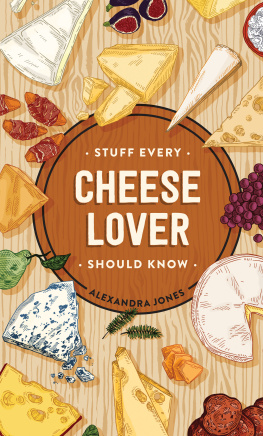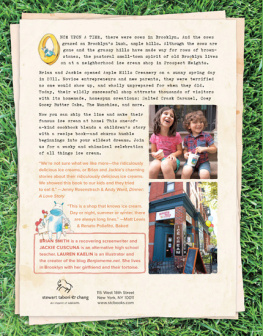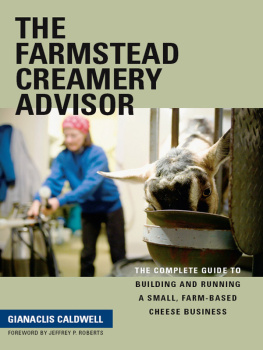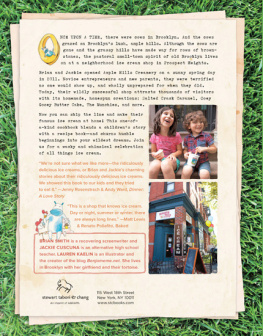



This book is dedicated to Bambi McDonald, whose spirit, humor, and love of food and friends continue to inspire.

TEXT COPYRIGHT 2013 BY SUE CONLEY & PEGGY SMITH.
PHOTOGRAPHS COPYRIGHT 2013 BY HIRSHEIMER & HAMILTON.
ALL RIGHTS RESERVED. NO PART OF THIS BOOK
MAY BE REPRODUCED IN ANY FORM WITHOUT WRITTEN
PERMISSION FROM THE PUBLISHER.
ISBN 978-1-4521-2632-6
THE LIBRARY OF CONGRESS HAS CATALOGED THE PREVIOUS EDITION AS FOLLOWS:
ISBN 978-1-4521-1163-6
DESIGNED BY SARA SCHNEIDER
PHOTOS ON USED COURTESY OF THE STRAUS FAMILY.
THE PHOTOGRAPHER WISHES TO THANK:
We work on many book projects, but having the opportunity to work with the ever gracious, energetic, forward-thinking, brilliant, dynamic, fun-loving Sue Conley and Peggy Smith was an especially gratifying collaboration. It was a pleasure and an honor to photograph this wonderful book. We thank them for asking us to do it. We want to thank the whole Cowgirl Creamery corral, you are a grand group! During this project, we were very lucky to make our home base in Marshall, California, in Madeleine Fitzpatrick and Evan Shivelys charming house perched over the waters of Tomales Bay. Thank you for your hospitality. Thank you Ann Spivack, for having such a lovely way of keeping us focused. To the talented people at Chronicle Books: thank you for honoring the photographs. Bill LeBlond, not by accident you publish beautiful book after beautiful book. Sara Schneider, you design the prettiest books around.
CHRONICLE BOOKS LLC
680 SECOND STREET
SAN FRANCISCO, CALIFORNIA 94107
WWW.CHRONICLEBOOKS.COM
INTRODUCTION
Rain rat-tat-tatted onto the metal roof of our barn like a hail of BB pellets. It was a cold day in March 1997, just hours before the grand opening celebration at Cowgirl Creamery in Point Reyes Station. Both of us were working intently on the cleaning and final food prep for the party, when Sue said, Were not quite ready. Peggy replied, Nobody is going to come out to Point Reyes in this weather anyway.
But people did come. Local chefs Evan Shively and Madeleine Fitzpatrick rolled up in their pizza truck with their copper-clad pizza oven secured in the back. We could see Evan from the wide barn door, building the fire while raindrops bounced off his broad-brimmed hat.
Some of the best chefs we knewGail Pirie, John Clark, Catherine Brandel, Mary Jo Thoresen, and Curt Clingmanwere in the back cooking, all of them pitching in to keep the food coming out for the guests.
Terry Sawyer, John Finger, and Michael Watchorn drove down from Hog Island, shuttling enormous sacks of oysters through the crowd. Within minutes, they began shucking oysters on our back counter. Kate Arding, just off a plane from London, set up an architectural display of Lancashire, Cheddar, and Stilton wheels and started cutting cheese for the people who gathered around her.
The Straus family made their way through the crowd and soon after them came Nan McEvoy, who was the president of the San Francisco Chronicle at that time, beside Michael Bauer, the Chronicles food editor. Then Sues Bettes Diner business partners, Bette and Manfred, arrived, followed by some old friends who had helped us fund our cheesemaking venture and negotiate loans: Joanne Casey, Warren Wilson, John Goyak, Peter Barnes, Peggy Janosch, and Bambi McDonald.
Peggy had crafted our invitations by hand, using a charming paper cut-out of our barn, and Eleanor Bertino, who handled public relations for many famous chefs, had delved into her impressive Rolodex and mailed invitations to some of the Bay Area food mavens who had inspired us. Alice Waters was one of the first to arrive, along with a small cadre from the Chez Panisse family. Even though we had invited them, it was still a shock to see Chuck Williams and Marion Cunningham come through the door under huge black umbrellas, with big smiles for us.
The ranchers from Point Reyes and Marshall came, then the neighbors and local politicians, including Steve Kinsey and our agricultural commissioner, Stacey Carlsen; even some of the townspeople who had protested our project joined the celebration.
As the evening wore on, the room filled to capacity. We began running out of our allotment of wine and cheese, and had to pull more from our retail stock. We had emptied every bottle of wine in our store and served almost all of the cheese we had in stock before the guests began to leave. Many of the people youll read about in the pages of this book were at that opening party.
WHY CHEESE?
In this book, well share how we learned to make cheese and why we were inspired to start a food business in a small agricultural town. Because both of us began our careers as cooks, we have included some of our favorite recipes and cooking techniques.
We eat a lot of cheese in the United States. Per capita, each of us eats about a pound of cheese per week, most of it grated over fast-food pizza or melted over grilled ground beef in the form of a cheeseburger. This cheese comes mostly from postWorld War II factories that churn out as much as one million pounds of cheese per day with the goal of producing food as cheaply as possible.
As Americans become more aware of the unique qualities of handmade cheese, they are actively seeking small-production artisan and farmstead cheeses. Artisan is a term used in Europe to describe cheese made in small batches using a local source of milk. The term farmstead is reserved for producers who make cheese on the same property where the animals are milked. Artisan and farmstead cheesemakers are the people well focus on in this book. But the terms artisan and farmstead do not tell the whole story of how the dairy is managed or how the cheese is made.
HOW BIG IS YOUR VAT?
The first question we always ask a cheesemaker is how big is your vat? Vat size tells us the cheesemakers scale of production; small-batch cheeses can often prove to be the most interesting. We are always on the lookout for unique regional cheeses that express the individuality of the cheesemaker and the place where they are produced. By the late 1960s, the few small-scale cheesemakers operating in Americas rural communities had all but disappeared. Cheesemaking in the United States began to shift in the 1970s when the back to the land movement lured young people to farmland on the edge of cities. Goats were raised, cows bought for milking, and a new generation explored the art of cheesemaking. Four decades later, this small group of pioneers has inspired many cheesemakers to pursue their dream, and mentored them along the way.
Cowgirl Creamery is one of the companies that came on the scene in the 1990s, inspired by the cheesemaking pioneers of the 1970s. The first wave of artisan cheesemakers focused on honing their craft and establishing a market for their cheese. By the time we embarked on our cheese adventure, American cheeses had begun to rival the nuance and quality of the great cheeses from England and Europe, but they had unfamiliar names like Humboldt Fog, Wabash Cannonball, and Camelia. We were happy to introduce these cheeses to the marketplace at our shop in Point Reyes Station when we opened our doors in 1997. We continue to spread the word on great American cheese today.
Next page











